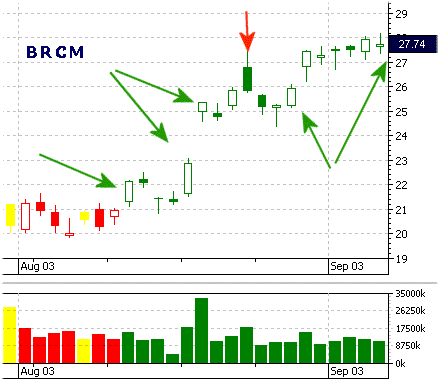Swing Trading
Post on: 25 Июль, 2015 No Comment

How to Trade with C2Vtrader
Instructions:
Swing Trading the SSO and SDS ETF’s in your Trading Account or IRA
The C2Vtrader Indicator trading system is always trading the SSO or SDS ETF’s, which are based on tracking the performance of the S&P500 Index times 2.
- When the S&P500 rises in value by 1%, then the SSO ETF gains 2% in value. Conversely, the SDS ETF loses 2% in value.
- The opposite is true when the S&P500 loses value by 1%. The SSO ETF loses 2%, but the SDS ETF gains 2% in price.
In other words, when we are LONG in the market, we buy SSO shares, and when we are SHORT the market, we buy SDS shares.
When trading the SSO or SDS ETF shares, there will always be two separate trades for each SSO / SDS C2V Indicator signal. A Sell then a Buy.
Log into your IRA or trading account and enter a MARKET ORDER to SELL your ETF position for next market OPEN. So, when the market opens, your order(s) will be filled at MARKET (which means that the market will fill your order(s) at whatever the current price is at that moment).
1. Sell any holdings from our previous trade. In your trading account, enter a MARKET ORDER to SELL all shares of SSO or SDS at OPEN, depending on which ETF you are holding from the current trade.
2. Once the shares have sold on the next trading day, then calculate 25% of your portfolio again to use on the next trade. As an example, if you have $100,000.00 in your trading account, you would simply multiply $100,000 by .25, which is $25,000 — that is how much money you could use to buy your shares with. But please use a percentage that you are comfortable trading with (i.e. 5%, 10%, 20%, 35%, etc).
3. Take note of the current trade ETF symbol in the table above — Enter a MARKET ORDER to BUY the most number of shares of SSO or SDS as you can with the money you calculated from in Step #2.
Swing Trading Stocks and ETF’s in your Trading Account or IRA
When the C2V Indicator flags a buy signal for an individual stock or ETF, then do the following:
Since we are trading multiple trades typically, an easy way to figure out how much money to risk per trade would be to trade using 3%, 4%, 5%, etc, for each trade. In other words, if we are trading 8 trades, then 8 x 3% = 24% of your total portfolio.
1. To trade a regular stock or ETF, simply calculate 3% of your portfolio to use on the current stock trade. As an example, if you have $100,000.00 in your trading account, you would simply multiply $100,000 by .03, which is $3,000 — that is how much money we suggest you use to buy your shares with. Please use a percentage that you are comfortable trading with (i.e. 3%, 4%, 5%, etc).
3. Take note of the current stock symbol to buy in the table above — Enter a MARKET ORDER to BUY the most number of shares of the stock as you can with the money you calculated from in Step #1.
Anticipate that we could be trading 6-8 trades at any given time. But if you only wanted to trade 4 trades, for instance, then maybe a 6% trade allocation would be appropriate.
An important note on safety:
Frequently, we will be trading multiple stocks at the same time, so make sure the total of all stocks trades at any given time does not exceed your 25% allotment for the system. Risk increases dramatically by trading with too much money in the market at any given time.
If the C2V Indicator is LONG in the market:
These instructions assume you are already in cash from our last C2V Indicator trade.
Login to your 401k account, and buy 25% of your portfolio into one or two stock mutual funds good for the next trading day.
For example, if you have $100,000.00 in your 401K, you would simply multiply $100,000 by .25, which is $25,000, or you should use whatever percentage you are comfortable with.
Most 401k’s offer a mutual fund or two that specialize in US blue chip growth stocks (i.e. a mutual fund that holds Microsoft, Dell, etc, as their key companies). Those types of funds are good candidates for our system. If you feel you want to be more aggressive, then buy a Small-cap growth fund(s) instead of or in addition to the the Blue chip fund(s).
If the C2V Indicator is SHORT the market:
Login to your 401k account and sell all stock and bond mutual funds you may be holding, and simply transfer that money to CASH, or a CASH-equivalent mutual fund.
A company’s 401k typically doesn’t allow you to SHORT the market, or in other words, allow you to profit from a falling market, so we just simply sit in CASH until the next C2Vtrader Indicator buy LONG signal. However, sitting in cash at the right time can be extremely beneficial to your 401k, specially over the long-term.
Note: There may be restrictions on the number of transactions you can place in a given timeframe in your 401k. We advise you to research the rules and regulations for your particular 401k.














